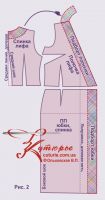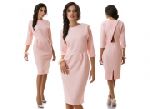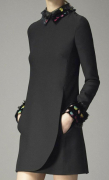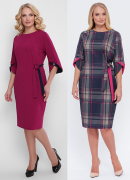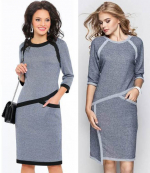Size charts What is the height of the pattern Payment methods Ask a question Reviews
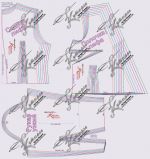 How to sew a straight dress with a one-button wrap on a finished pattern with your own hands
How to sew a straight dress with a one-button wrap on a finished pattern with your own hands
Contents of the instruction:
- Pattern description.
- What patterns are included with this straight sheath dress.
- Description of the design and possible sewing options for this style.
- What to sew a sheath dressing gown with one button and how to calculate fabric consumption.
- How to buy and download ready-made patterns of a sheath-robe dress with a printout on a home printer.
- How to cut a straight sheath dress with a wrapper according to a finished pattern.
- How to sew a straight sheath dress on home sewing machines.
Buy and download this dress pattern
Pattern Description
 Electronic pattern of a straight sheath dress with a wrap on one button 40-64
Electronic pattern of a straight sheath dress with a wrap on one button 40-64
Sizes: 40-52 and 52-64 - the buyer receives ALL sizes of the selected gradation.
File format for download in order:
PDF in full size and without seam allowances.
After paying for the order, you will receive links to download two files dress patterns selected gradation of sizes:
- PDF A4 file adapted for printing patterns on sheets of A4 paper in any program on any device, including mobile phones.
- Multi-format PDF file for printing on sheets of any size from A0 to A4 on a printer or plotter using Adobe Reader.
Sewing difficulty level: medium. You will need the skills to try on a cut-off dress.
The pattern is designed for sewing at home on household sewing machines.
Complete set of patterns of a dress of a case of a direct dressing gown
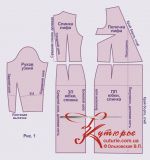 (picture 1):
(picture 1):
- Back pattern: bodice and RF skirt (RF - back half).
- Shelf pattern: bodice and PP skirt (PP front half).
- Pattern of a sleeve narrow with landing.
Sprout facing patterns (back neck) and collars are not included in the set of patterns, but below it is described how to cut them using the patterns from the set.
Description of design and style variations
As the name of the style says, this is a straight sheath dress. The shelf performs the smell, so the dress can also be called a dressing gown.
If the main type of style is a "robe", then a strict business dress can be considered an additional one. To do this, the smell of a bathrobe can be replaced by its imitation - a one-sided warehouse. In a dress with a pleat, it is better to fasten the dress in the side seam.
What to sew a straight sheath dress from and how to calculate fabric consumption
 Traditionally, straight dresses are sewn from woolen dress fabrics - the fabric must be sufficiently "plastic" for wet-heat treatment so that the tops of the tucks do not bulge in the finished product.
Traditionally, straight dresses are sewn from woolen dress fabrics - the fabric must be sufficiently "plastic" for wet-heat treatment so that the tops of the tucks do not bulge in the finished product.
You can also use heavy fabrics from the silk range.
An ideal option for sewing a straight sheath dress would be natural woolen or silk fabric with a small amount of synthetics to protect the dress from shrinkage.
Pure wool and pure silk fabrics will require dry cleaning and very careful wear, therefore, they should be considered only in exceptional cases.
Suit fabrics can also be considered a good option.
An acceptable option, but requiring a higher qualification of a home couturier, can be pile fabrics - velor or velvet. Of course, it is worth excluding stretch velvet, from which “sports” suits are so fond of sewing.
Instructions on how to buy, how to print yourself and others
How to choose a size without using tables and taking measurements.
How to buy a ready-made electronic pattern.
How to print a pattern at home in full size on A4 sheets or on sheets of any other size.
How to assemble a pattern after printing.
Ready-made patterns of dresses in full size download for free.
Buy and download this dress pattern
How to cut with your own hands a straight dress sheath-robe according to a finished pattern
Before cutting, in order not to make mistakes, it is advisable to cut out a facing from paper or doubler for a sprout and a selection of shelves and a skirt (picture 2).
As mentioned above, we cut out the facing for the sprout along the pattern of the back without seam allowances. Turning width 4 - 5 cm.
 It is important that the width of the facing is equal to the width of the selection of the shelf along the shoulder cut, as shown in 2 drawing.
It is important that the width of the facing is equal to the width of the selection of the shelf along the shoulder cut, as shown in 2 drawing.
In fact, the selection of a shelf is a strip of fabric. Therefore, you can cut out a rectangle with a little margin, and cut off the sloping lines of the shoulder and waist later, when you iron the collar.
The skirt hem is also a strip of fabric and there are no nuances here.
Seam allowances are standard for custom-tailoring a detachable sheath dress or dressing gown.
In other words, allowances are added taking into account the fitting, in order to take into account the features of the customer's figure.
The allowance for the waist of the bodice is very important - we add 3 - 4 cm - it will allow not only "to adjust the dress to the desired height", but also take into account the peculiarities of the posture and the size of the chest. Many home couturiers mistakenly believe that only the tuck determines the fit of the bodice. In fact, you need to pay attention to three parameters:
1) the length of the bodice, which can be changed unevenly during the fitting;
2) solution and tuck top;
3) the position of the armhole.
In order to clarify these three components of an ideal fit during the fitting, we add allowances - 3-4 cm along the bottom of the bodice, and a "house" to the tuck.
No seam allowances are added for the armholes, neckline, and hem, as adding seam allowances will make the curves much shorter. We do not add an allowance along the waist section of the skirt.
 To the rest of the cuts - 1 - 1,2 cm. At the bottom of the dress (skirt) - traditional 2,5 - 3 cm for a hem with an open cut (overcast, fold and hem).
To the rest of the cuts - 1 - 1,2 cm. At the bottom of the dress (skirt) - traditional 2,5 - 3 cm for a hem with an open cut (overcast, fold and hem).
Figures 3 - 4 show the cutting of a straight dress with a wrap on one button.
Let's take a closer look at the layout for small sizes (picture 3)
As you can see, in this figure, the patterns of the RFP and PP of the skirt are combined into one piece along the side seam. The advantage of this cutting option lies not only in saving time for processing side seams. Most inexpensive dress fabrics containing synthetic fibers or consisting entirely of them make it difficult to beautifully clean the seams that coincide with the share direction. Such seams often turn out to be a little tight even for experienced couturiers.
The share thread of the bodice of the shelf can be located both along the edge of the side, and parallel to the half-skid. For loose and easily deformed fabrics such as dress wool, it is better to position the shelf, as shown in fig. 3 and 4, but for pile fabrics, the half-skid must strictly coincide with the share, otherwise the product cannot be worn.
 Let me remind you that a semi-skid is the middle line of the product, corresponding to the middle line of the figure in front. The semi-skid should be marked on all the details of the shelf and kept until the product is ready. In dressing gowns and coats, the half-skid of the left and right shelves should match.
Let me remind you that a semi-skid is the middle line of the product, corresponding to the middle line of the figure in front. The semi-skid should be marked on all the details of the shelf and kept until the product is ready. In dressing gowns and coats, the half-skid of the left and right shelves should match.
As shown in the figures, when cutting blanks (or patterns) of the bands, they are placed next to the shelf and the PP of the skirt. Of course, experienced tailors can simply mark out pickup points.
About large size layout (picture 4) you can only add that before cutting the sleeves, you should unfold the fabric lunge remaining after cutting the remaining parts and fold it across.
Features of a do-it-yourself pattern of a dress with a fold instead of a smell
Now about the variation with a fold, instead of a smell, which can turn a frivolous dressing gown into a strict office dress.
In fact, cutting a straight office sheath dress does not differ from cutting a straight dressing gown. There is only one feature - the width from the vertical edge of the bead to the fold of the fabric (picture 5).
Let's take a closer look at Figure 5: it shows the first stage of cutting. The fabric is folded in half face to face across the width
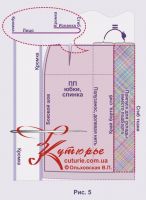 PP + allowance for one-sided stock,
PP + allowance for one-sided stock,
where the stock allowance is equal to the distance from the half-skid to the edge of the side.
Next, we lay out the remaining bodice and RFP of the skirt, then the sleeves and the facing of the sprout, as shown in fig. 3 and 4.
How to sew a straight dress with a wrap on one button with your own hands at home
A very important point - on one button and with one loop, which should be at waist level or 2 - 3 cm higher, that is, in the thinnest place of the figure. Therefore, the most important moment in sewing this dress is the fitting, on which the length of the bodice is adjusted and, accordingly, the position of the seam of the connection of the bodice with the skirt, in which the same loop can be located.
 The location of the loop in the seam is evidenced by the possibility of avoiding the loop in the most visible place of the product.
The location of the loop in the seam is evidenced by the possibility of avoiding the loop in the most visible place of the product.
- Preparation for fitting - dubbing and ironing of the bands, processing of darts, side and shoulder seams, processing of the sleeve. In other words, three “knots” should be ready for fitting - bodice, skirt, sleeves. It is better to grind with a line for sweeping. Slightly priputyuzhivat stitched necessarily! Without an iron and high-quality assembly, a high-quality fitting will not work.
- Fitting. As it was written above, we try on the bodice, combining the half-skid, tie the bodice with a cord, outline the waist, adjust the position of the tuck and armhole lines. Having cut the armhole, we put on the sleeves and mark two points on the okat, except for the already existing highest point. Two additional points are also marked on the adjusted armhole for tacking, which correspond to the points marked on the collar. Then, try on the skirt.
- We make changes to the fitting and process the bodice, skirt and sleeves separately.
- We knit the sleeves according to the marks that were made on the fitting.
- We process the sprout
- We sweep, connecting the bodice and skirt.
- We note the selection.
- After that, you can conduct another fitting.
- We finish work on the dress by finally connecting the bodice with the skirt, skipping the stitching for the buttonhole, and processing the bottom of the dress and the sleeve.
As for sewing a straight dress with a pleat, the zipper in the side seam is processed after connecting the bodice to the skirt.
Download this pattern pdf:
Pattern of a straight sheath dress with a smell on one button
$2.00 (80 hryvnia)
Bank cards of the Russian Federation are not accepted for payment!
Size charts What is the height of the pattern Payment methods Ask a question Reviews
Vera Olkhovskaya in social networks:

See similar clothing patterns and how to sew on them
-
Any pattern for free for a review of a previously made order
More...
Lifetime promotion for buyers of patterns!

Leave a review about my store of patterns for an order that you made before, and you will receive any paid pattern of your choice Free!

